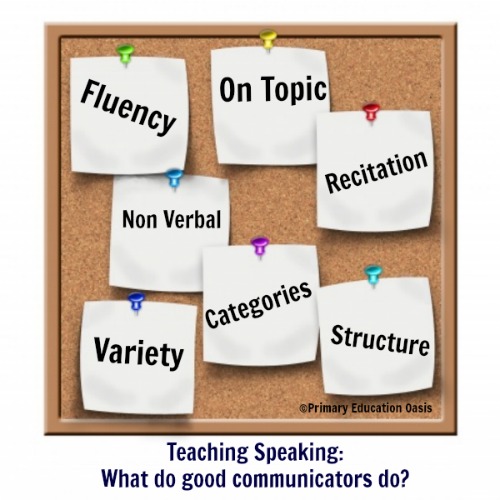Teaching speaking is is about training students how to integrate skills to deliver oral “presentations” without articulation difficulties . Learn what to look for that could signal speaking problems.
Speaking problems arise for young students when they have difficulties blending cognitive, lexical, syntactic, listening and comprehension skills. Basically, that means they have issues with:
- following a conversation
- figuring out what to say
- and getting it out
Our kids have to be able to blend these skills to deliver effective social and classroom discourse. If any of these parts is lacking, specific steps towards teaching speaking skills must be taken.
The speech teacher isn’t always available, so it is up to the classroom teacher to help develop this communication skill.
Speech Articulation
How well a student articulates is the grand-daddy of all speech activities.
Without developmentally appropriate articulation, a student will suffer from intonation, pitch, voice quality and fluent speech patterns.
There are four distinct areas of the speaking domain under articulation:
- Mechanics and Characteristics
- Vocabulary
- Structure
- Applications
Language Structure
The structure of language in speaking refers to how language is organized and produced. An effective speaker in classroom discourse (conversation) will use a variety of complex sentences and grammatical complexities.
Effective speakers also understand how to vary their language structure based on the purpose of the conversation and the situational aspects.
Teaching Speaking: Effective Language Structure Skills
The student should:
- Use a variety of sentence types
- Use direct and indirect quotes correctly
- Connect sentences and word choices with appropriate logic
- Use subject, verb, noun and pronoun forms correctly
- Be able to use transitional words to connect thoughts and ideas for smooth flow of speech
- Use higher-level prefixes and suffixes correctly (intervene with teaching vocabulary activities)
- Use regular and irregular verbs correctly
Speaking and Vocabulary
The importance of vocabulary cannot be stressed enough. An efficient speaking vocabulary allows the student to express appropriate thoughts, ideas, needs and feelings.
Many students that show youth at risk behavior in the classroom suffer from a deficient working vocabulary.
This will effect not only their classroom performance, but also the non-academic settings.
Teaching Speaking: Effective Speaking Vocabulary
The student should:
- Use specific vocabulary to accurately communicate ideas, feelings and needs
- Be able to label events, actions and objects accurately
- Understands and uses prepositional phrases, synonyms, antonyms and homophones
- Can create categories and name the categories for objects (i.e. fish, vegetables, dogs)
- Use multiple meaning words correctly in context
- Uses many types of figurative language when speaking (idioms, similes, metaphors)
- Can use Greek and Latin roots, prefixes and suffixes to derive meaning (as is age-appropriate)
Speaking Applications
Speaking applications is just what is says: how well a student can blend and use the skills of speaking.
Students speaking applications will become more sophisticated as they get older. At the basic level, primary students will work on applications through songs, rhymes, poetry and retelling stories.
Older students will show their applied speaking skills through oral reports, presentations and debates. In all cases, teaching speaking genres is appropriate as the application will vary with the structure and purpose of speech.
Teaching Speaking: Effective Speaking Applications
The student should:
- Speak with age appropriate fluency
- Vary types of language used according to the situation, purpose and audience
- Be able to organize and deliver information (show and tell, report, explain how math problem solving strategies were used)
- Be able to recite poems, songs, finger-plays and rhymes
- Make appropriate contributions to whole-group discussions
- Be able to use different strategies to overcome public speaking problems (practice, lists, outlines, notecards)
- Utilize both verbal and non-verbal expressions to convey meaning
- Be able to stay on topic, redirect and continue a discussion
